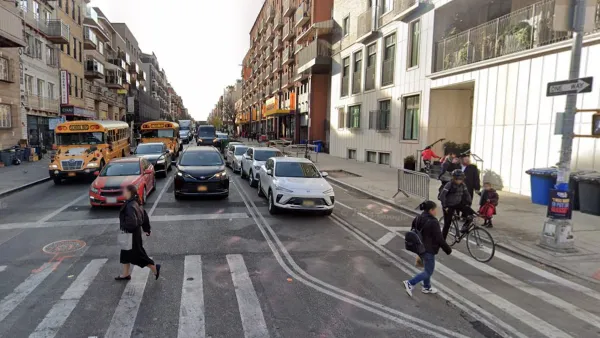Pedestrian malls, a common urban design goal of the 1960s and 1970s have so fallen out of fashion that failed examples from history are cited as boogeyman like "bridges to nowhere" and "big digs."

"Once upon a time in the 1960s and 1970s, urban leaders pushed cars out of downtown. Why is it so hard to do that now?"
That's the provocative discussion posed by Curbed design critic Alexandra Lange to inspire a history of pedestrian malls, starting with an origin story from the imagination of Victor Gruen, through several decades of failed attempts at attracting suburban shoppers back to downtown, to the recent history of the planning and design of urban pedestrian spaces, informed by lessons from the failures of the past and built in smaller numbers around the country.
"The pedestrian mall was an urban phenomenon, one with a clear boom-and-bust cycle," writes Lange. "From 1959 through the early 1980s, more than 200 American cities closed blocks of their downtowns to car traffic. By 2000, fewer than 24 of those original malls remained."
Of those pedestrian malls, Lange examines the example of Fulton Mall in Brooklyn for lessons in what makes urban pedestrian malls successful:
Fulton Mall’s success offers clues as to why only two dozen of 200 pedestrian malls remain from the boom a half century ago. The future of the pedestrian mall is not in trying to save downtown merchants by bringing new shoppers in, but in improving the experience for the shoppers who are already there.
As always with urban design, there are multiple social, economic, and design factors at play in the success of shopping districts, which is why raising pedestrian malls as a boogeyman doesn’t make sense in the first place. But three factors stand out: foot traffic, anything-but-car access, and amenities beyond retail.
For examples of recently renovated, still functioning examples that have done a better job of embedding those lessons, Lange mentions the 16th Street Mall in Denver and the Nicollet Mall in Minneapolis. There are more pedestrian mall projects on the way in New York City too, like Willoughby Square Park and a new public realm plan for Downtown Brooklyn, which includes the Fulton Mall.
FULL STORY: Who’s afraid of the pedestrian mall?

Planetizen Federal Action Tracker
A weekly monitor of how Trump’s orders and actions are impacting planners and planning in America.

Map: Where Senate Republicans Want to Sell Your Public Lands
For public land advocates, the Senate Republicans’ proposal to sell millions of acres of public land in the West is “the biggest fight of their careers.”

Restaurant Patios Were a Pandemic Win — Why Were They so Hard to Keep?
Social distancing requirements and changes in travel patterns prompted cities to pilot new uses for street and sidewalk space. Then it got complicated.

Platform Pilsner: Vancouver Transit Agency Releases... a Beer?
TransLink will receive a portion of every sale of the four-pack.

Toronto Weighs Cheaper Transit, Parking Hikes for Major Events
Special event rates would take effect during large festivals, sports games and concerts to ‘discourage driving, manage congestion and free up space for transit.”

Berlin to Consider Car-Free Zone Larger Than Manhattan
The area bound by the 22-mile Ringbahn would still allow 12 uses of a private automobile per year per person, and several other exemptions.
Urban Design for Planners 1: Software Tools
This six-course series explores essential urban design concepts using open source software and equips planners with the tools they need to participate fully in the urban design process.
Planning for Universal Design
Learn the tools for implementing Universal Design in planning regulations.
Heyer Gruel & Associates PA
JM Goldson LLC
Custer County Colorado
City of Camden Redevelopment Agency
City of Astoria
Transportation Research & Education Center (TREC) at Portland State University
Camden Redevelopment Agency
City of Claremont
Municipality of Princeton (NJ)




























